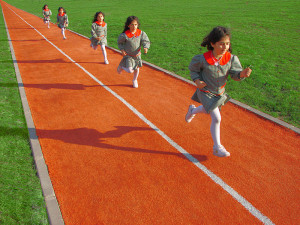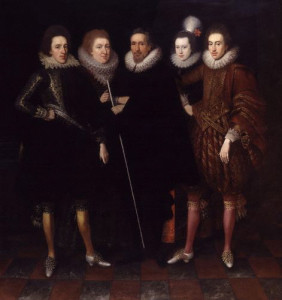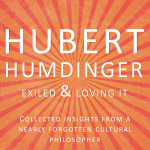Walking the 405 Freeway; How A Good Pair of Shoes Can Make You Faster
ADAM MICHAEL LUEBKE
Los Angeles
I don’t know about the actual laws on the books, but supposedly it’s forbidden to take a walk on the 405 freeway. Yet someone had dared do it.
Traffic seemed to be backed up for miles. I was stuck in the mess. But I didn’t know the cause of all the consternation until I saw, between my lane and the next, a bobbing figure far ahead.
The only fast moving cars were in the carpool lane. The rest of us suffered from the knee-jerk reaction of hitting the brakes and then gently driving past the man strolling in the middle of the freeway. There was no choice but to slow and creep forward.
 The walker wore a plain rust orange t-shirt on top of loose light blue slacks. A stain, brown or purple, spotted his back right thigh. He walked freely, with an easy gait. Possessed he was, with the air of Mr Rogers putzing to the glue factory so his audience at home could see what happens to old horses when they are no longer vigorous.
The walker wore a plain rust orange t-shirt on top of loose light blue slacks. A stain, brown or purple, spotted his back right thigh. He walked freely, with an easy gait. Possessed he was, with the air of Mr Rogers putzing to the glue factory so his audience at home could see what happens to old horses when they are no longer vigorous.
Many drivers honked their horns. Some shouted obscenities out their windows. But not many. And not until they were at least a few yards ahead of the man and traffic was moving at least five miles an hour. Nobody could quite tell what this man was capable of. He maybe even had a gun tucked into his waistband.
So most drivers, I saw, politely inched right or inched left to give the man courtesy room.
I had the good fortune to pull up to his right. Traffic nearly stopped at that point. I glanced over at him. He was focused, staring ahead, like a man on a tightrope, except without the strain or stress of falling to his death.
I said to myself, You only live once. Talk to the bastard and see what’s on his mind.
__________________________________________________________________________________________________
“Excuse me, pilgrim,” I said out my open window, “how’s the stroll?” I had to shout, also, over the squeaks and squeals of drivers applying their brakes, and then the roar of dozens of engines idling or accelerating.
He turned his face toward me. He resembled more than a little the former president George Bush Jr. The gray hairs modestly flared out around the buffoon’s ears. He did not return my smile. “I love the way this concrete feels under these shoes,” he said.
I knew the feeling of a pleasing surface on which to walk. The way a quality pair of shoes will clutch the pavement, the way the rubber treading will conform to the minutest contours of the road as the walker plants his foot, and then shoves off without the least bit of slippage, either between the shoe and pavement, or the foot and the shoe.
Even one sloppy component about a pair of shoes, either in its tread or in how it fits the foot and ankle, an expert walker will detect it, and that flaw will nag him with every step. There is little better these days — in a world in which civilization is quickly falling apart — than the comfortable snugness of consciously-crafted footwear.
Ahead of me, the line of cars gained distance. Vehicles piled up behind me. Somebody blew their horn. My new, slightly unhinged friend was not perturbed.
“It’s partially these shoes, and it’s partially this lane,” he said, “with the little grooves in it to wear out your tires faster,” he told me. His forearms were pink from the sun exposure. The skin of his forehead looked tight, tanned.
“You can’t get that same experience on a sidewalk,” I shouted to him.
He shook his head very seriously. “No, you cannot.”
__________________________________________________________________________________________________
His shoes were of a track and field variety. Not so fashionable, but the soles were made especially to grip and release.
“I’ve had a pair of shoes like that,” I told him, pointing out my window at his kicks. “Let me tell you, I’d never wear them in public because they look goofy. Too American. Too casual. So I wear these less comfortable brown shoes. But they don’t clench the sidewalk very well. I got used to the lesser quality, though, until I tried on an old pair of running shoes like yours, and oh boy, I felt like I was gliding. Almost like skating,” I shouted. “Each step sliced into the pavement and I think I cut my walking time to the grocery store in half.”
“Some shoes make you faster,” he said. “That’s not a myth.” The walker leaned forward (a little pretentiously, I thought) and swung his arms from side to side for a few steps, as if he were a speed skater.
 “Some shithead in grade school told me that about his sneakers,” I hollered. “He said to me, ‘You wanna know why I’m so fast?’ Of course I did, because he was the fastest kid in third grade. He was a blur from one end of the school’s playground to the other. I can still picture the white and red flashes of his shoes all these years later.”
“Some shithead in grade school told me that about his sneakers,” I hollered. “He said to me, ‘You wanna know why I’m so fast?’ Of course I did, because he was the fastest kid in third grade. He was a blur from one end of the school’s playground to the other. I can still picture the white and red flashes of his shoes all these years later.”
Horns were blaring behind us. How many, I could not tell. At least three. One driver held hers continuously while others peppered it with staccato bursts.
The cars ahead of me had made considerable distance. I wanted to finish my story. And my freeway friend was interested, I could tell, even though he didn’t seem fond of smiling. Once you know what a person loves, you can relate any personal experience to them through that lens and they’ll connect to you.
“‘It’s these shoes,’ the kid told me. ‘They make you faster.’ As soon as I was off the bus and home with my mother I told her I needed those shoes. Problem was they were 150 dollars. My mother had a fit. ‘Shoes don’t make a person fast,’ she said, exasperated because I kept saying that clearly I’d seen living proof they did. ‘It’s the person’s muscles that make him fast.’
“As an adult,” I told my new friend, who still strode as happily as if he were strolling through a quiet neighborhood, “I apologized to my mother for being such a stupid kid. ‘Sorry to put you through that hell with the faster shoes bit, mother,’ I’d told her a few years ago. But now I’m not so sure anymore.”
My friend wiped his forearm across his face. “The more you live,” he said, “the more you learn.”
I told him I’d be happy to give him a lift. “What freeway entrance did you get on, anyway?” I asked. “How far have you been walking?”
“I don’t know,” he said, holding out one hand, “I’m not keeping track of my mileage.”
Behind us, far in the distance but closing fast, was the sound of sirens.
“You know,” I said, “the authorities won’t understand this. Most of them don’t live for subtleties and simple pleasures like enjoying the grip of one’s shoes on the particular tread of 405 freeway concrete. The only thing some of these officers appreciate is gripping their 9mm as it kicks each time it’s fired. You’d better hop in so I can spirit you away and drop you off somewhere safe.”
The man knew I was talking sense. My Midwestern, Nordic features lend a practicality to my words. And we’d already struck a common bond. He signaled ‘right’ with his hand. I stopped the vehicle. The horn honking behind us started up again. My new, very sweaty friend hopped into the passenger seat. I gunned the engine and we took off like a shot off a shovel. I asked him where he lived.
“Westchester,” he said.
“They say that’s a great place to trick-or-treat,” I told him.
 “Phenomenal,” he said. “I always dress up like Sir Robert Carey, the First Earl of Monmouth. He walked 2000 miles across Europe in 41 days,” my friend said. “That was 1608.”
“Phenomenal,” he said. “I always dress up like Sir Robert Carey, the First Earl of Monmouth. He walked 2000 miles across Europe in 41 days,” my friend said. “That was 1608.”
“I’ll bet the kids love that,” I said, “when they come to your door and see you dressed up as the First Earl of Monmouth.”
“They are more interested,” he said, with not even a smile, “in the assortment of goodies I’ve got to offer them.”
“Like protein power bars. I’ll bet that’s what you hand out. Nutrition bars.”
“Why would I do that?” he asked and shook his head. “No child likes protein bars. I hand out the good stuff. Candy. Chocolate.”
“If only Robert Carey were alive these four hundred years later to get a technologically advanced pair of sneakers and jet off on the pleasantly-grooved freeway expanse,” I said.
“I think Sir Carey walked enough in his lifetime to be satisfied,” my solemn friend said.
When I asked him what his name was, he said that was the type of question he’d like to avoid. “Too invasive,” he said. “Too personal.” But he did tell me where he lived. He guided me right, then left, straight ten blocks, right at that light, left at the next stop sign, and so on until we stopped in front of a large white house with twin white columns in the front.
“What a great porch to sit out on and have coffee or tea and talk about walking,” I said.
“A great porch never gets used as much as its owner intends it to,” he said. “With all the hassles and responsibilities of life. People don’t sit around enough. As soon as you do get a chance to sit, someone nags you right back onto your feet again.”
We said goodbye. Not a word of thanks for the lift, though. I suspected he’d have happily walked home anyway. Like a good friend I waited to be sure my buddy was able to get into his house before I drove off. Rather than producing a key, he knocked at the door. He knocked steadily, for many seconds, until finally the door flew open. A woman in a yellow summer dress stood in the doorway. Her long gray hair was positioned neatly over one shoulder. She moved her hands frantically. She sawed at the air.
My friend, from what I could see of his back, stood motionless with his hairy arms at his sides. His stained blue walking pants were grubby next to the clean white paint of the house, and the freshly cultivated garden of flowers lining the walkway to the front door. The woman inside thrust her arm out with as much care and vigor as the Fuhrer, and she pointed one finger toward the sky.
“Well,” I said, “I’ve been of enough assistance for one day. What else can I do? He’s on his own now.” I put the car into drive.
As I rolled up the passenger window (which I’d lowered to cool and dry off my freeway friend), I heard the woman’s voice as she shouted one final order. “Why don’t you take a hike!” she said and slammed the door.
[405 freeway photo from Mariordo (Mario Roberto Duran Ortiz); speeding girl photo from Nevit Dilmen; Sir Robert Carey (third from the left) painting by Paul van Somer, 1617]



Priceless, Adam! Maybe this “Walkin’ Charlie” figure is a harbinger of a future time–say, 25,000-50,000 years from now–when a race of fully conscious beings will stroll leisurely–and roller skate (4-wheel, not in-line)–on deserted freeways overgrown here and there with billowing meadows, apple trees, hollyhocks and wild strawberries.